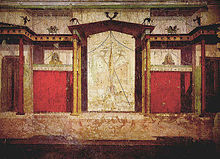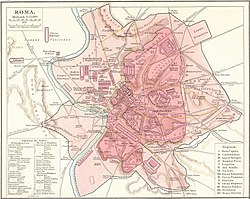Domus Augusti

Fresco in the House of Augustus.
|
|
| Location | Palatine Hill |
|---|---|
| Type of structure | Domus |
| Related | List of ancient monuments in Rome |
The House of Augustus, or the Domus Augusti, is the first major site upon entering the Palatine Hill in Rome, Italy. Historically, this house has been identified as the primary place of residence for the emperor Augustus. The Domus Augusti is located near the so-called Hut of Romulus and other sites that have connections to the foundation of Rome. This residence contained a complex of structures that were situated around the Temple of Apollo Palatinus.
The Domus Augusti should not be confused with the nearby Domus Augustana, part of the vast palatial complex constructed by Emperor Domitian on the Palatine in 92 CE.
In 1865, Pietro Rosa began excavations at what is now called the House of Livia. His excavations, part of a larger program commissioned by Napolean III, included a superficial excavation of the Domus Augusti, located to the south.In 1937, Alfonso Bartoli did further surveys of the area and found archaeological remnants of collapsed vaults. In 1956, extensive excavations began under Gianfilippo Carettoni. His initial excavations revealed a structure, consisting of a set of rooms, which has now been identified as part of a larger complex known as Peristyle A. He attributed this structure to Augustus based on its proximity to the nearby Temple of Apollo. In the early years of 2000, further work was done, which led archaeologists to posit that the original peristyle was part of a much larger house. A restoration program, said to have cost almost two million euros, was completed in 2008, giving the public access to the rooms excavated by Gianfilippo Carettoni.
The House of Augustus is heavily attested in ancient literary sources. Suetonius' work indicates that Octavian moved into the House of Quintus Hortensius on the Palatine, relocating from his original home in the Roman Forum.Velleius reports that after, Octavian began to purchase the land surrounding House of Hortentius. Soon after, this spot was struck by lightning, and so Octavian declared this a public property and dedicated a temple to Apollo, known as the Temple of Apollo Palatinus, as Apollo had helped Augustus in his victory over Sextus Pompey in 36 BCE. And because of this pious act, as Cassius Dio states, the senate decreed that the property around this area should be given to Augustus from public funds. The oak crown, said to have adorned the front door, was a tribute to this senatorial dedication in 27 BCE. Suetonius speaks of it in the past tense, so it may be presumed that it burned during the fire of Nero.
...
Wikipedia

